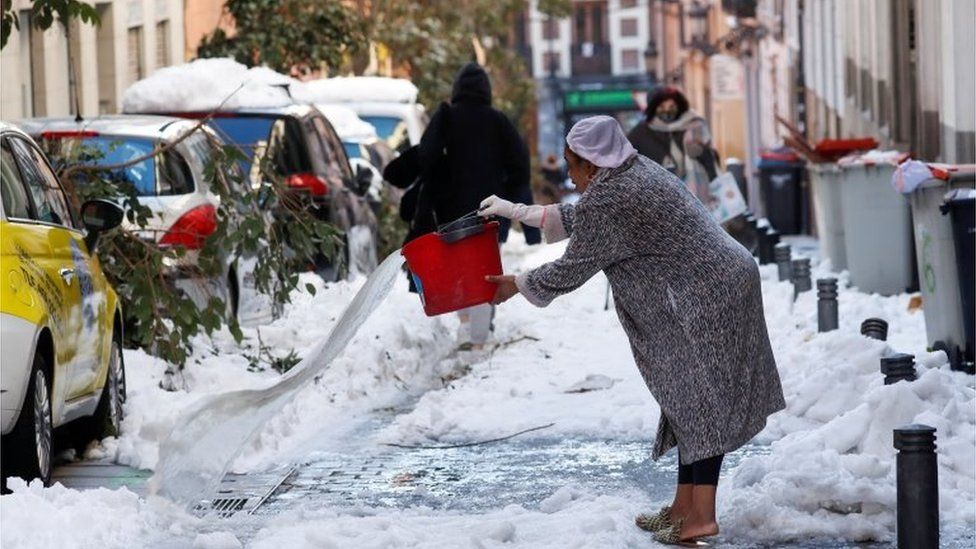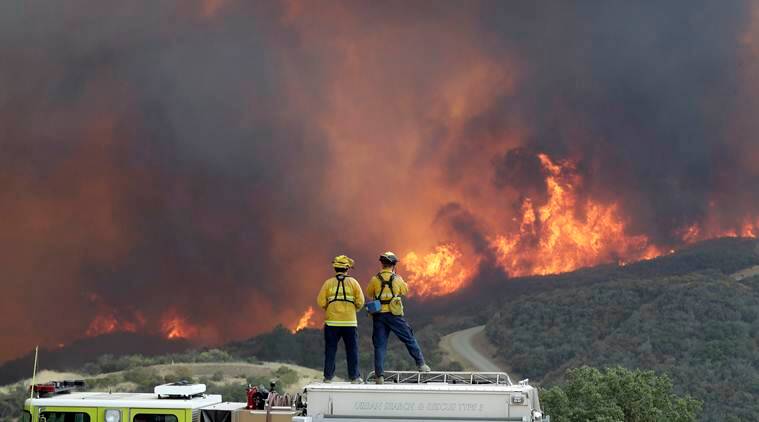The world is experiencing unusual weather conditions and the frequency, intensity, and impacts of some types of extreme weather events are contributing to climate changes. Read the causes, impacts, and solutions for these extreme weather conditions.
| Sudden temperature changes and sudden weather changes are already part of natural anomalies in 2021.
Consider this- – Snowstorms were witnessed in Athens and if this was not enough then in Saudi Arabia. The storm also delivered some of the lowest temperatures so far in 20-21 winter to parts of the region.
Image Source: BBC • In North America, tornadoes have been increasing in their intensity. • Spain experienced the coldest March day in 82 years. During the day, the temperature dropped by 20°С; • In Siberia, in the Republic of Khakassia, there was suddenly abnormal warming; • Abnormal temperature contrasts were observed in Greece, • In Iceland, on the Reykjanes peninsula, Fagradalsfjadl a volcano erupted, after for more than 800 years; • In Peru, abnormal and torrential rains were the cause of landslides and floods, • The southern United States was hit by storms, hailstorms and many tornadoes, whose frequency and number exceeded all previous years • Large-scale forest fires in Mexico affected area of more than 7,000 hectares; • Australia saw one of the worst floodings in recent decades has. More than 18,000 people were evacuated; • India experienced abrupt summer onset without an intervening spring and that may have been the cause of glacial disaster in Uttarakhand. Unusual weather phenomena are growing in intensity and frequency every year and every day. These weather aberrations have an overriding effect on the lifestyle of the people, their established way of living, and their fears about the future. In an uncertain world, these unusual weather phenomena make everything even more uncertain and unusual with an attendant impact on adjustments. When tropical cyclones carry a stronger gust than that has been known, then it forces everyone to think about the next step and method of adaptation. It forces us to rethink new technologies, new ways to forecast and warn people in a region not subjected to such severity. The entire life, thinking and response go topsy turvy. The eastern Siberian landscape in winter covered in snow, but in summer, its forests are lush and its wetlands soggy. In 2019, the region experienced a fire, along with large parts of the Arctic Circle. Globally 2019 summer was the hottest June on record. Not only that temperature increases are taking place, but because also that the effects of global warming are not evenly distributed. Moreover, there are strong indications that the Arctic is warming twice as fast as the rest of the planet. The impact in the Arctic is its increasing vulnerability to fires and Arctic fires are now a reality. A very large number of above-ground fires have been recorded by satellites, covering thousands of hectares in the Arctic and sub-Arctic, extending from Eastern Siberia to Alaska and Greenland. These fires that emanate from within the Arctic Circle have produced more than 100m tonnes of carbon dioxide, or roughly what a small country like Belgium emits in a year. The impact of all such weather aberrations is that we do not know the solutions or even adjustments. Imagine the Arctic fires
Image Source: Indian Express Fighting fires that have grown to such extent in remote regions that it is difficult or impossible with few roads. Other than that, such natural peat fires can only be managed by pumping billions of gallons of water over land, and the water table can’t be raised for an area the scale of Northern Alaska or Siberia. When it snowstorms in deserts, people and residents are actually caught unawares completely confused about a solution, or adjustment to it on a short-term or long-term basis. Climatic aberrations have a likely impact in the form of inviting new viruses, new strains of diseases not to speak of new catastrophes. The greatest source of such aberrations is global warming, and some of the likely impacts that global warming will lead to is not known to human beings. A small temperature rise in the Arctic has the potential to release carbon locked in cold waters, increase the acidity of the oceans that will dissolve the calcareous skeletons of marine microscopic organisms which will in turn release more carbon dioxide into the atmosphere and its concomitant effect on Arctic warming. When this happens there will be no reverse gear. Forest fires will increase in intensity in the Arctic. Many Siberian and Alaskan fires will be burning carbon-dense peat soils, which is normally waterlogged. Peat fires when they take place, produce much more carbon dioxide and methane from the combustion of carbon. This carbon has been locked in the permanently frozen ground for thousands of years. Add to it the burning of the soil that has the capacity to eliminate important carbon sinks that cannot be replaced on a human timescale. Fires in the Arctic will become a much bigger consequence because of their potential of releasing large amounts of stored greenhouse gases. Nature will play its part in all changes that take place, and the change will remain the only constant but we if collectively do not do anything towards respecting our weather, we are really in for some serious trouble and its concomitant domino effect. |
About the Author
|






 K Siddhartha is a renowned Civil Services Preparation Mentor and Thought Leader. He has more than 20 years of experience and has mentored over 1550+ civil servants, film personalities, entrepreneurs, and policymakers. Mr. K Siddhartha is the author of 43 books & 116 research articles. He is frequently invited as a speaker on global platforms. (Views are personal)
K Siddhartha is a renowned Civil Services Preparation Mentor and Thought Leader. He has more than 20 years of experience and has mentored over 1550+ civil servants, film personalities, entrepreneurs, and policymakers. Mr. K Siddhartha is the author of 43 books & 116 research articles. He is frequently invited as a speaker on global platforms. (Views are personal)
